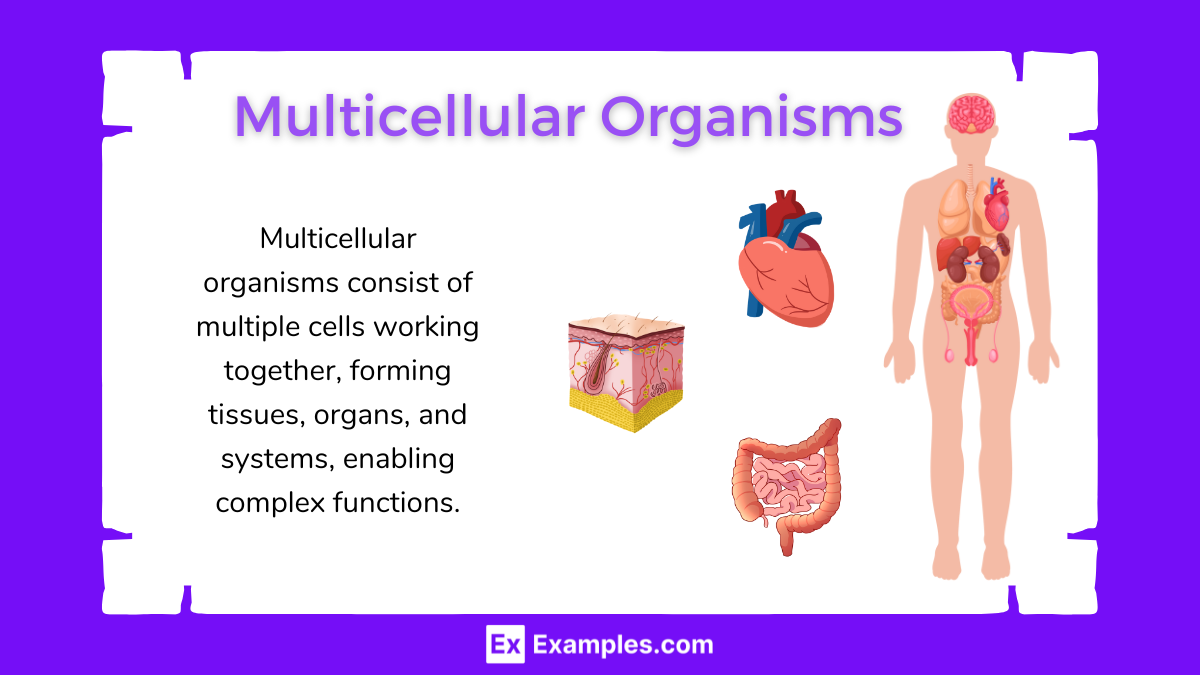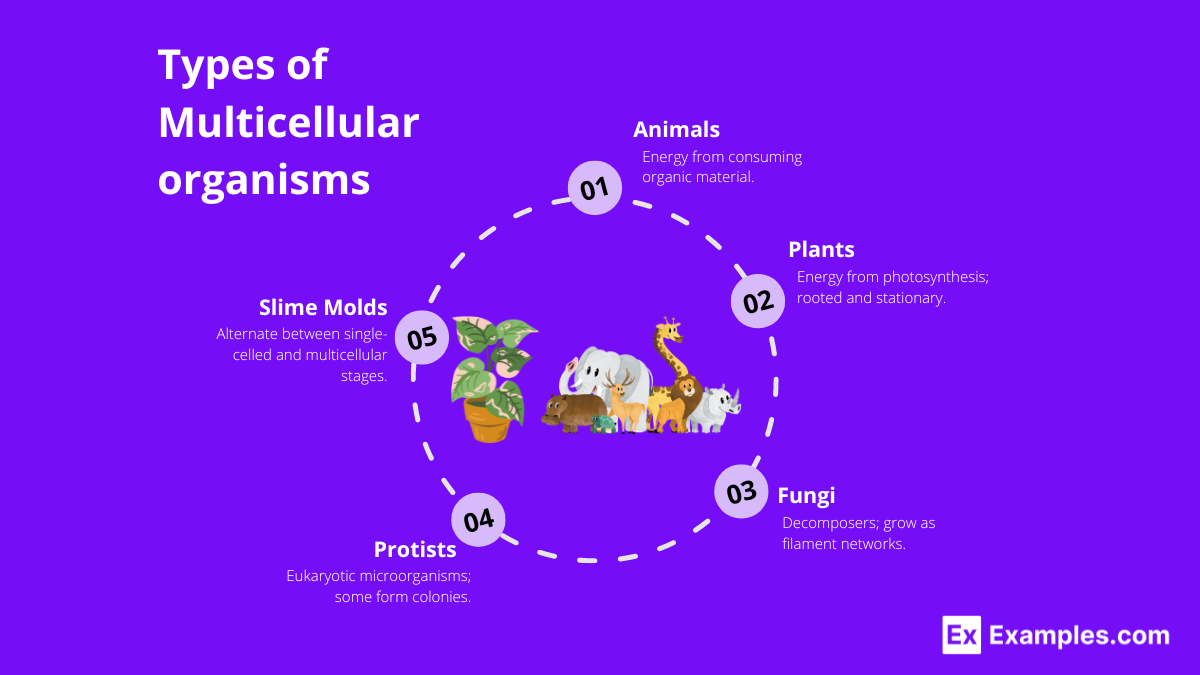What is a defining characteristic of multicellular organisms?
They can live in extreme environments
They are made up of more than one cell
They reproduce asexually only
They lack specialized cells


Multicellular organisms, composed of more than one cell, represent a significant leap in the complexity of life on Earth. These organisms exhibit a remarkable level of organization, where cells specialize and work together to perform various functions essential for survival. From simple sponges to complex mammals, multicellular life forms dominate the planet, showcasing a wide array of structures and capabilities. This article delves into the fascinating world of multicellular organisms, exploring their origins, the advantages of multicellularity, and the diverse strategies they employ to thrive in various environments.
Multicellular organisms are living entities composed of more than one cell, with cells organized into complex structures that perform various functions. Unlike unicellular organisms, which consist of a single cell, multicellular organisms have cells that specialize and cooperate to maintain the organism’s life processes.

Plants are primarily autotrophic, using photosynthesis to convert sunlight into energy. They range from simple mosses and ferns to complex flowering plants and trees. Plants play a crucial role in ecosystems by producing oxygen and serving as a primary food source.
Animals are heterotrophic, obtaining energy by consuming other organisms. This group includes a vast array of species, from simple invertebrates like sponges and insects to complex vertebrates such as fish, birds, and mammals. Animals exhibit diverse forms and behaviors, adapted to various environments.
Fungi are primarily decomposers, breaking down organic material and recycling nutrients back into ecosystems. This group includes molds, yeasts, and mushrooms. Fungi form symbiotic relationships with other organisms, such as mycorrhizal fungi with plant roots.
Although often considered protists, many algae are multicellular and share characteristics with plants, such as photosynthesis. Algae are found in aquatic environments and range from microscopic phytoplankton to large seaweeds like kelp.
This diverse group includes multicellular organisms that do not fit into the other kingdoms. Examples include certain types of algae and slime molds. Protists exhibit a wide range of life forms and modes of nutrition, from photosynthetic to heterotrophic.
Reproduction in multicellular organisms is essential for the continuation of species and involves complex processes that ensure genetic diversity and the successful development of offspring. There are two primary modes of reproduction in multicellular organisms: sexual and asexual reproduction.
Sexual reproduction involves the combination of genetic material from two parent organisms, resulting in offspring with a mix of traits from both parents. This process generally includes the following steps:
Asexual reproduction involves a single parent organism producing offspring that are genetically identical to itself. This mode of reproduction is common in simpler organisms but also occurs in many multicellular organisms. Common methods include:
Nutrition is a vital process for multicellular organisms, providing the necessary energy and nutrients to sustain growth, development, and maintenance of bodily functions. Multicellular organisms exhibit diverse nutritional strategies, broadly categorized into autotrophic and heterotrophic nutrition.
Autotrophic organisms, such as plants, algae, and some bacteria, can produce their own food through photosynthesis or chemosynthesis.
Heterotrophic organisms cannot synthesize their own food and must obtain energy and nutrients by consuming other organisms. Heterotrophic nutrition can be classified into several types:
Multicellular organisms are composed of various levels of biological organization, each building upon the other to create the complexity seen in these organisms. Here is a breakdown of the composition of multicellular organisms:
In plants, similar levels of organization exist, with tissues such as dermal tissue, vascular tissue (xylem and phloem), and ground tissue, and organs like leaves, stems, and roots forming organ systems that support the plant’s life functions.
Multicellular organisms consist of various specialized cell types, each with unique structures and functions that contribute to the organism’s overall survival and functionality. Here are some of the primary cell types found in multicellular organisms, particularly in humans and plants:
Multicellular organisms consist of multiple cells working together, forming tissues, organs, and systems, enabling complex functions.
Multicellular organisms have specialized cells for different functions, unlike unicellular organisms that perform all life processes within a single cell.
Examples include humans, plants, animals, fungi, and some algae.
They grow through cell division, differentiation, and development, increasing their size and complexity.
Advantages include specialized functions, greater complexity, increased size, and ability to adapt to various environments.
Types include animals, plants, fungi, and some protists and algae.
They reproduce sexually or asexually, involving the production of specialized reproductive cells.
Cell differentiation is the process where cells become specialized to perform specific functions.
Cell communication ensures coordination and function of different cells, tissues, and organs for the organism’s survival.
Main characteristics include multiple cells, cell specialization, complex structure, and the ability to perform various life functions.
Text prompt
Add Tone
10 Examples of Public speaking
20 Examples of Gas lighting
What is a defining characteristic of multicellular organisms?
They can live in extreme environments
They are made up of more than one cell
They reproduce asexually only
They lack specialized cells
Which of the following is an example of a multicellular organism?
Bacteria
Yeast
Mushroom
Amoeba
What is the primary advantage of being multicellular?
Ability to move faster
Greater complexity and specialization of functions
Reduced energy requirements
Simpler reproduction
In multicellular organisms, what is the role of stem cells?
To perform specific functions in tissue
To provide structural support
To differentiate into various cell types
To aid in digestion
Which of the following systems is typically found in multicellular organisms but not in unicellular organisms?
Digestive system
Reproductive system
Respiratory system
All of the above
What type of tissue in multicellular organisms is responsible for movement?
Epithelial tissue
Connective tissue
Nervous tissue
Muscle tissue
How do multicellular organisms typically achieve homeostasis?
By using only one cell type
Through communication between specialized cells
By consuming nutrients from the environment
By replicating their cells
Which of the following is NOT a characteristic of multicellular organisms?
Cellular specialization
Complex organization
Ability to live independently
Development from a single fertilized egg
In which way do multicellular organisms reproduce?
Only through binary fission
Asexually or sexually
Only through fragmentation
Exclusively by budding
What type of organism is classified as multicellular eukaryotes?
Bacteria
Fungi
Archaea
Viruses
Before you leave, take our quick quiz to enhance your learning!

